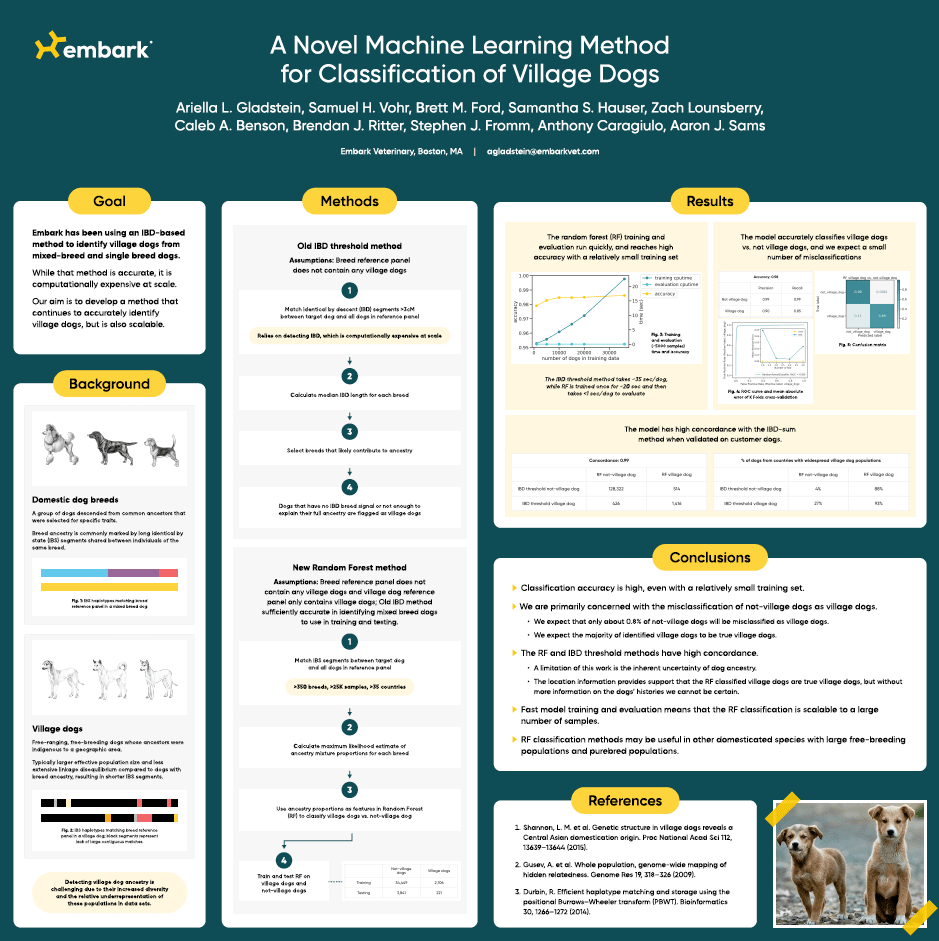Did you know that most of the dogs in the world are not descended from modern breeds? There are about a billion dogs in the world, but only a fraction of them are purebred or mixed-breed pets. The majority of dogs in the world are a unique kind of dog, called village dogs.
Here, with help from our Science team, we’ll explain what village dogs are, what makes them unique, and how we identify village dog ancestry in Embark-tested dogs.
What are village dogs?
Village dogs are free-ranging, free-breeding dogs whose ancestors were indigenous to a geographic area. In effect, they are the descendants of the founding population of dogs in a region. Although they are not recognized by kennel clubs as a breed, they are genetically identifiable, with many different village dog populations around the world.
There are many different types of village dogs and they can differ from each other depending on what part of the world they live in. Village dogs can vary in appearance, but in general, they tend to be medium in size with pointy snouts. They usually live near humans.
Learn more about these special dogs with Embark cofounder Dr. Adam Boyko.
Why are village dogs important?
Village dogs are important because they help us understand topics like where dogs came from, the history of domestic dogs, and how dogs and humans learned to live together.
Village dogs were the founding populations of many modern breeds. So, while a village dog does not have ancestry from modern breeds, their ancestors may have contributed to the founding of today’s dog breeds.
Even though these dogs are important, they have not been extensively studied in genetic research. To learn more about these special dogs, Embark cofounders Ryan and Adam Boyko traveled around the world studying village dogs, along with a Cornell University–led research team. Their research, which suggested that dogs may have originated in Central Asia, led to the founding of Embark.
How are village dogs different from breed dogs?
Humans helped shape modern dog breeds, selecting for specific traits. In contrast, village dogs were not bred by humans.
Genetically, village dogs are different from breed dogs because instead of being subjected to artificial selective pressures (via human directed breeding) like domesticated breeds, their genetic variation is shaped by natural evolutionary forces, including neutral genetic drift and natural selective pressures, which confers geographic adaptations. This leads to village dogs being more genetically diverse than domesticated dog breeds and sharing smaller segments of DNA with other dogs than dogs with recent ancestry from domesticated breeds.
How are village dogs different from Supermutts?
Village dogs are different from the “Supermutt” result that Embark provides. Village dogs are a distinct type of dog and are not descended from modern breeds. Each type of village dog has a unique genetic signature that we can use to identify village dog ancestry.
The “Supermutt” result means that a dog has ancestry from multiple different breeds, but the DNA match is so small that they can no longer be confidently assigned to any one particular breed. This happens when dogs descend from other dogs that were themselves mixed breed. The further in the past your dog has purebred ancestors, the smaller the identical segments matching our reference dataset are.
In other words, a village dog’s ancestors were likely also from the same population of village dogs. In contrast, a Supermutt’s ancestors were not Supermutts themselves; they were modern breed dogs—the genetic signature has just worn down over time.
Types of village dogs
There are many different types of village dogs from regions all over the world. Embark tests for more than 50 types of village dogs, including:
- Afghanistan And Pakistan Village Dog
- American Samoa Village Dog
- Anguilla Village Dog
- Antigua And Barbuda Village Dog
- Aruba Village Dog
- Bahamas Village Dog
- Bahrain Village Dog
- Barbados Village Dog
- Belize Village Dog
- British Virgin Islands Village Dog
- Caicos Islands Village Dog
- Central African Village Dog
- Central American Village Dog
- Central Asian Village Dog
- Chinese Village Dog
- Colombia Village Dog
- Costa Rica Village Dog
- Cuba Village Dog
- Djibouti Village Dog
- Dominica Village Dog
- Dominican Republic Village Dog
- Ecuador Village Dog
- Egyptian Village Dog
- Fiji Village Dog
- Greece Village Dog
- Grenada Village Dog
- Guam Village Dog
- Hong Kong Village Dog
- Indonesia Village Dog
- Israel Village Dog
- Jamaica Village Dog
- Japan Village Dog
- Korean Village Dog
- Kuwait Village Dog
- Mexican Village Dog
- Northern Mariana Islands Village Dog
- Oman Village Dog
- Panama Village Dog
- Papua New Guinea Village Dog
- Peru Village Dog
- Philippines Village Dog
- Puerto Rico Village Dog
- Qatar Village Dog
- Romanian Village Dog
- Russian Village Dog
- Saint Kitts And Nevis Village Dog
- Saint Lucia Village Dog
- Saint Martin Village Dog
- Singapore Village Dog
- Solomon Islands Village Dog
- South Asian Village Dog
- Southeast Asian Village Dog
- Trinidad And Tobago Village Dog
- Turks Islands Village Dog
- United Arab Emirates Village Dog
- West African Village Dog
- West Asian Village Dog
- Western European Village Dog
- Yucatan Mexico Village Dog
If your dog has ancestry from any of these village dog populations, you’ll see it in their Embark results.
How does Embark identify village dogs?
About 1% of Embark-tested dogs come from populations of village dogs.
“Because village dogs have higher genetic diversity than other dogs, and because they have been underrepresented in research data sets, detecting village dog ancestry is challenging,” explains Ariella Gladstein, PhD.
Embark uses an algorithm that accounts for these different genetic factors to analyze breed ancestry. Our genetic ancestry models rely on comprehensive sampling of the diversity of our large reference database and our ability to identify long, identical tracts of DNA between those dogs and yours.
The algorithm matches segments of shared DNA, called identical by descent, that indicates that the DNA was inherited from a shared ancestor. For example, if a dog has a segment of DNA that is also in the genome of a particular breed, we can match their DNA with that breed.
A new machine learning method
Our Science team developed an improved method for identifying village dogs from mixed-breed and single-breed dogs. Compared to our previous method, this new method relies on a similar matching principle, while also using machine learning. The advantage of machine learning is that it has the same high accuracy as the previous method while making our analysis process faster.
“This new method is so interesting from a scientific perspective, because the machine learning model can easily learn to identify village dogs based on the genetic data we provide,” says Dr. Gladstein. “It allows us to continue identifying village dogs with the same accuracy as before, but in a way that is more efficient and scalable and works really well.”
How to understand your dog’s results
So, you’ve gotten a village dog result. That’s exciting! Your dog is the descendent of dogs who have likely lived in that geographic area for generations. Their genetics and traits have been shaped not by humans, but by natural evolutionary forces, allowing them to adapt to their environment.
We know that if you’re expecting a breed mix reveal for your dog, finding out they are actually a village dog may feel disappointing at first, but this result actually tells a rich history of your dog’s ancestors and their past.
Village dogs were central to the beginnings of Embark, and we are excited to learn more about them. With more research, we will likely be able to infer interesting histories about various village dog populations.
Interested in learning more about dog ancestry? Read about the Australian dingo, an ancient, wild canid that likely descended from wild dogs, or learn more about the shared history of dogs and humans.













